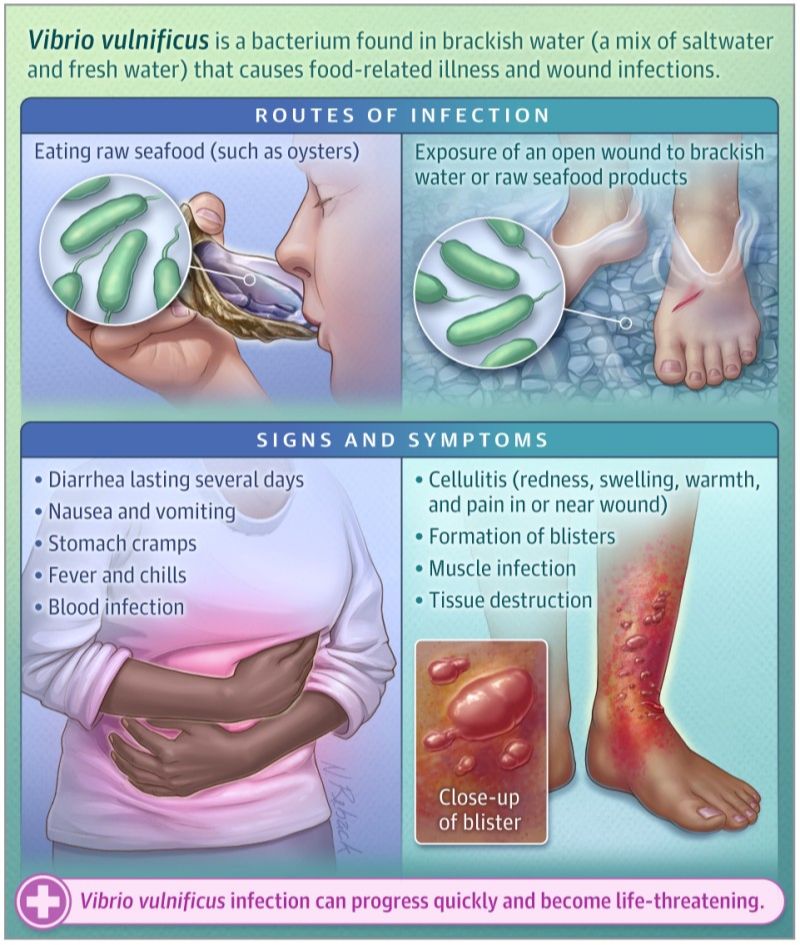Vibrio Vulnificus (Flesh-eating bacteria)

What is Vibrio vulnificus?
Vibrio vulnificus, commonly referred to as the flesh-eating bacteria, is a type of bacteria that lives in warm saltwater. It's not always harmful, but in certain conditions, it can cause severe infections in humans.
Who’s at risk for Vibrio vulnificus?
People with weakened immune systems, like those with chronic liver disease, diabetes, or other conditions that reduce their immunity, are more vulnerable to infection. Those who have open wounds and come in contact with infected saltwater or raw seafood, especially oysters, can also be at higher risk.
What causes Vibrio vulnificus?
This bacteria naturally reside in warm coastal waters, especially during the summer months. Infections can occur when an open wound comes into contact with water that contains the bacteria or by consuming contaminated seafood.
How does Vibrio Vulnificus start?
There are two main ways the infection can start:
-
Wound Infection: When someone has an open cut or wound and they go into warm salt water containing the bacteria, the bacteria can enter through that wound.
-
Eating Contaminated Food: Consuming raw or undercooked seafood, particularly oysters that haven't been properly cooked, can lead to infection if the seafood is contaminated with bacteria.
What are the symptoms of Vibrio vulnificus?
Symptoms vary based on how a person was infected:
-
Through a wound: The skin might become swollen, red, painful, and develop blisters. There can be a discharge or even ulcers.
-
By consuming contaminated food: Symptoms might include vomiting, diarrhea, abdominal pain, fever, and chills.
In severe cases, symptoms can escalate and lead to sepsis, a life-threatening condition.
How is Vibrio vulnificus diagnosed?
A doctor will typically ask about recent activities, like swimming in saltwater or consuming seafood. Laboratory tests, especially cultures of the wound or blood samples, can confirm the presence of the bacteria.
How can Vibrio Vulnificus be treated?
Early diagnosis and treatment are crucial. The infection is usually treated with antibiotics. In severe cases, especially where the bacteria has affected the skin and tissue, surgery may be necessary to remove dead tissue.
What complications may occur with Vibrio vulnificus?
If not treated promptly, the infection can lead to septic shock, a life-threatening condition where blood pressure drops drastically. This can lead to organ failure and, in some cases, death. Skin infections can cause the death of skin and tissues, sometimes requiring amputation.
How can I prevent Vibrio vulnificus?
- Avoid swimming in warm saltwater with open wounds.
- Wear protective gloves when handling raw seafood.
- Always cook seafood, especially oysters, thoroughly.
- Keep open wounds clean and covered.
Long-term management of Vibrio vulnificus
If treated promptly, many people recover without long-term issues. However, those with severe infections might need longer periods of treatment and rehabilitation, especially if surgery or amputation was required.
What is recent research saying about Vibrio vulnificus?
Recent research is exploring climate change's role in the increase in cases, as warmer waters may encourage the growth of this bacteria. Scientists are also investigating new treatments and ways to predict outbreaks.
Where can I go for more information on Vibrio vulnificus?
For more information, visit the Centers for Disease Control and Prevention (CDC) website or consult with infectious disease specialists. Local health departments can also provide updates and resources on current outbreaks or risks in specific regions.

